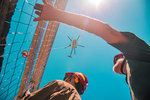
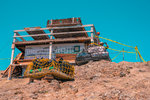
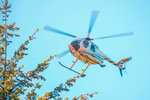


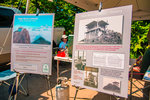
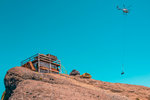


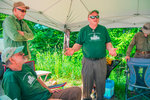
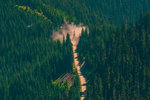

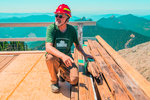



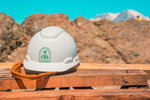

This time of year, High Rock Lookout is generally crawling with visitors.
Locals and tourists alike make the painfully steep trek up Sawtooth Ridge to stare in awe at the panoramic views of Mount Rainier, Mount St. Helens, Mount Adams and the many summits jutting into the sky.
But on Tuesday, those hundreds of hikers were replaced by a small crew steadily making their way to the 90-year-old historic fire lookout — what appears as a dot in the sky from the trailhead.
Orange and white butterflies peacefully glided across the seemingly-vertical ridge and were soon joined by a much larger flying creature: a roaring helicopter descending onto the rock.
The nimble aircraft thundered down, whipping dust off the peak. Crews grabbed onto its 100-foot cable, hooking it to cargo-netted bundles of wood, each one weighing hundreds of pounds.
After several trips from the peak to the trailhead, the helicopter did a final fly-by and the team caught their breath.
“That was so cool. That was so cool,” exclaimed Mary Prophit, Randle’s library manager who volunteered her manual labor.
Tuesday was the latest phase in a years-long restoration effort of the 1930s-era fire lookout. Of the 80-some lookouts that once dotted the Gifford Pinchot National Forest, only five remain, said Rick McClure, the archaeologist and U.S. Forest Service veteran helping spearhead the project.
Affectionately called “Save the Rock,” the project is a joint effort between the White Pass Country Historical Society, Oregon preservation organization Sand Mountain Society and the U.S. Forest Service.
With the goal of preserving the much-loved lookout, volunteers spent weeks this summer deconstructing it — a painstaking process of de-nailing old wood, which is now on its way to Oregon to be stripped of lead paint. In 2023, another helicopter will return the material for reconstruction, returning the lookout to its glory days.
“It really freaking happened, after all these years of talking about it,” Prophit said.
The local has been making the trek to the lookout for years, taking her daughter to camp inside it and painting over graffiti.
Navigating the sky-high ridge and signaling to the chopper made for exhilarating work. And it was a relief to be done with what McClure called “hot, sweaty work.”
In June, mules hauled up the crew’s equipment, their metal horseshoes slipping on exposed rock and snow that hung to the trail up until last week’s heat wave. Breaking open a building as old as the High Rock lookout was like “exploratory surgery,” Allen said.
“Cleaning out the attic, we were cleaning out pack rat nests and a lot of really nasty stuff. Mouse poop, just tons of it, raining down on us,” McClure told The Chronicle.
The dead remains of an entire ant infestation also awaited McClure, Rob Hoeye and Sand Mountain Society President Don Allen III.
Plus, more structural issues abounded: dry rot, corner supports that had completely separated from the structure, a half-inch slump in the floor.
The goal, according to Allen, is to give the building a longer lifespan. In reality, the 1930s Forest Service fire lookouts — among the first to be built — weren’t designed to last. With a limited budget, they were “quick and dirty” designs, Allen said.
And with few roads and no viable helicopter option, pack animals were used to haul in relatively small pieces of wood. The 8-foot planks used at High Rock Lookout created weak points at each splice, McClure said.
After picking the structure apart, about 80-85% of the wood was salvageable.
On the peak, McClure pointed to a “burn pile” of rotted beams.
Replacement material will in part be taken from structures from the same era that were destroyed.
“At least the material gets reused. But we always hate to see the original buildings go away,” Allen said. “And it’s old growth fir, that original material, so it’s really valuable.”
After its founding in 1905, the U.S. Forest Service quickly prioritized fire detection, McClure said. That’s in part because of the devastating 1910 fire season in the Northwest — what Hoeye described as “apocalyptic.”
An economic boost under President Franklin Roosevelt in the 1930s meant fire lookouts across the country could be built. At the same time, an Oregonian inventor, William Osborne Jr., was perfecting his own firefinder, a device that would quickly become a staple in lookouts across the nation.
McClure, who co-authored an early history of the Gifford Pinchot National Forest, has the diaries from the district ranger who oversaw High Rock Lookout’s construction.
Back then, ceramic insulators — some still seen hanging from the trees — carried hundreds of miles of phone lines to lookouts. Without many roads, the response time, Hoeye noted, was measured in days.
The historical tidbit is one thread woven into the fabric of fire lookout legends that members of the Sand Mountain Society discussed earlier that day, sitting under a pop-up tent at the trailhead. Stories ranged from their fathers’ experience staffing lookouts to semi-fictitious tales.
Allen spoke of his dad’s work watching for fires, when an electrical storm pumped so much static into the structure’s ground wires that they glowed white.
Hoeye chronicled a sunny day, when three radios on separate peaks were taken out by a rogue lightning strike, stretching out of the sole cloud in the sky.
Other tales included lookout buddies mistakenly calling in a fire, only to discover it was the moon.
For the Sand Mountain Society, the lore of lookouts and American history cement their love for the High Rock Lookout. But not everyone has the same relationship with the structure, and as Tuesday’s work wrapped up, a major concern lingered.
What if, after the lengthy project is concluded, and the lookout is refurbished, the graffiti that’s plagued the structure returns?
The historical society hopes to post someone at the lookout during summers, which could deter the type of destruction that has proven heartbreaking to the lookout’s supporters. But graffiti could still crop up in the “shoulder seasons,” when it will lay empty.
“We really worry about that,” McClure said. “With the investment of time and money in this project, to have that happen would just be awful.”
Prophit spends her free time trekking up the mountain to paint over perennial Sharpie ink. On Tuesday, she balked about the many visitors who purport to love the building, only to slap a signature on the 90-year-old wood panels.
“My fear is exactly this: we put it up all nice, and the next week there’s Instagram handles,” she said.
McClure has always preferred a carrot over a stick. Instead of pointing to federal charges that can accompany the destruction of government property, he said hikers should visit their local historical society or library to learn about how special the structure is.
For those averse to history, he pointed to a more artistic avenue: famous Beat writers like Jack Kerouac and Gary Snyder.
“These guys wrote about lookouts and romanticized the experience at the fire lookout,” McClure said. “Even if they don’t care about Forest Service history of firefighting or fire protection, through these famous writers and poets who found these places to be very inspirational … if people look at these places in that way, maybe they won’t feel the need to be destructive.”